The present-day Gila River in the Gila Box Riparian National Conservation Area in southeast Arizona.
Both nature and nurture affect human obesity. For some people, and for some populations, the genetic tendency to become obese is not fulfilled because of their environment, the circumstances of their lives. But when those circumstances change, the genetic potential may be realised quickly, and lead to the medical issues that follow from obesity. An example that starkly illustrates this comes from the sunbaked desert south of Phoenix, Arizona. It involves a group of American Indians called the Pima, who live along the Gila River. Their experience over the past century and a half illustrates how profoundly changes in external circumstances can change a people’s health.
Obesity and type 2 diabetes in the Pima population
The Pimas are well known to scientists studying Type 2 diabetes mellitus (T2DM). This form of diabetes is sometimes called “adult onset diabetes”. It is characterised by high blood glucose levels, a specific group of metabolic dysfunctions, and degeneration of the kidneys and eyes, as well as a shortened life expectancy. Administration of insulin doesn’t prevent these effects. Obesity and genetics are contributing factors to the development of T2DM.
A number of indigenous groups in the world have high levels of T2DM. Of these, the Gila River Pimas are the worst off. In 1971, it was reported that 50% of their community over 35 years old had T2DM (1), and the situation has not improved since then. The change in this number over time is striking: in 1902, the American ethnologist Frank Russell, visiting the Pima for the Smithsonian Institute, saw no evidence of the symptoms of diabetes (2). His hosts described for him a number of plagues that had ravaged their health in the past, cholera and malaria among them. In 1902, tuberculosis was the most common fatal disease. But of 28 common, occasional, and rare diseases among the Pima, Russell saw no evidence of diabetes.
In 1937, Elliott P. Joslin, the first American doctor to specialize in diabetes, estimated that the incidence of diabetes was about the same among the Pima as in the general population of the USA. But it then began to increase, and by 1971 it reached the 50% number quoted above. This profound increase in T2DM was accompanied, as it usually is, by an equally dramatic increase in obesity. The story of how this happened is a strong reminder of the importance of living conditions on the occurrence of T2DM.
The Hohokam, ancient agricultural engineers
More than 2,000 years ago, a group of quite sophisticated agriculturalists lived in the Sonoran desert of Arizona, south and east of the present city of Phoenix. They are referred to as the “Hohokam”, “those who are gone”, by the Pima Indians who live there today. Their own ancestors may have migrated from an area further south more than 4,000 years ago. The Hohokam used the waters of the Gila and Salt Rivera to support their farming. When Russell visited the Pima in 1901 and 1902 (2), they knew almost nothing about the Hohokam, but their mythology suggested that they had been attacked and destroyed by invading tribes from the east.
The Hohokam lived in a desert that was subject to arid summers, with temperatures rising to over 40º C, but they had sufficient access to water from the rivers and shallow wells to live stable farming lives. At some time in the Current Era (in other words, after AD 1), they began simple irrigation practices. By 1,000 AD they had developed large and fairly sophisticated systems of canals and ditches, often lined with stones and adobe to diminish seepage into the sandy subsoil. Some of these canals are still in place, and are even used, today (Figure 1).

The farming technology of the Hohokam allowed them to grow cotton, corn, beans, and squash. They developed a culture which is gradually being uncovered by anthropologists. Pottery, jewelry, and ruins of some of their adobe buildings survive. One of these is a great house, originally four stories high, with walls several feet thick, called ‘Casa Grande’ by the Spanish who came to the area centuries later.
What happened to the Hohokam is not clear. They may have moved away because of aggression by other tribes. They may have diminished in numbers and later amalgamated with other indwellers to form the modern day Pima. Or they may simply be the sole ancestors of the Pima. In any case, the record of the Hohokam culture disappears around the fifteenth century. Some time later the ancestors of today’s Pima Indians began to live in the river valleys.
The river people
“Centuries ago the Hohokam Indians lived in the fertile valleys of the Salt and Gila rivers.” So begins a collection of the legends of the Pima Indians written by Anna Moore Shaw (3). Shaw was herself a Pima Indian, or, as they called themselves in earlier times, the Akimel O’odham, the River People. The Pima Indians of today live in an area south of Phoenix, Arizona, along the Gila River (Figure 2). Their location overlies what we know about the Hohokam lands.

At the time that Russell stayed with them, the Pima lived in eight village (possibly one or two more) along a thirty mile stretch of the Gila River. They were in a peaceable collaboration with another tribe, the Salt River Pima, and another small group, the Maricopa. All were closely related, and all were descendants either of those who arrived after the disappearance of the Hohokam or of the Hohokam themselves.
Although Spanish missionaries travelled in the general area years earlier, the first contact with Europeans was probably made by Father Eusebio Francisco Kino in 1694. Father Kino returned six times over the next 8 years, sometimes with a small group of soldiers, and claimed to have made some Christian conversions. The Spanish brought horses, wheat, and cattle as well, and these soon became important components of Pima farming. The interactions of the Pima with their Spanish visitors, like those with various other groups of travellers later, were cordial.
The Pima encountered by the Spanish were also farmers. They made use of some of the canals built by the Hohokam for irrigation, and took advantage of the rivers, the Gila and the Salt, to grow corn, squash and beans. The Gila River carries a high level of alkali salts, and irrigation would poison the soil over time; the Pima learned that the alkali could be washed out, and the land restored, by repeated deep flooding. The Gila also carried a lot of suspended solids, 10% or more by volume, and these enriched the agricultural lands during flooding.
In some years there was not enough water, and crops would do poorly. Then the Pima would have to scour the desert for food, but they didn’t abandon their village homes. They also had deep wells to obtain water for their crops when the river didn’t provide enough. They used the fruit of the giant saguaro cactus, the plant known as pigweed, and the beans of the mesquite plant to supplement their farmed produce.
The coming of the Americans
Much of what we know about 19th century life of the Pima is due to the well documented visit of the ethnologist Frank Russell, who stayed with them from November, 1901 until June, 1902 (2). At the time, the Gila River Pimas numbered about 4,100. They were relatively well off, compared to some of the neighbouring tribes, because of their productive, stable agricultural way of life. Russell spent time listening to the interpretations of elders of the record of the ‘calendar sticks’ they had begun keeping in 1833.
Russell described the Pima as being heavier than other groups of native peoples, but not obese. Their ordinary phenotype can be seen in the numerous pictures he took, which are consistent with observations made by travellers through Pima lands in the middle of the 19th century (Figures 3 and 4).
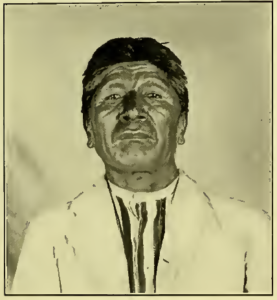
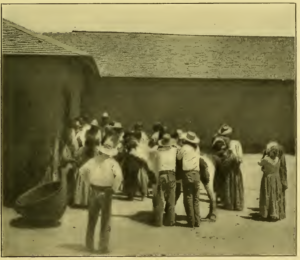
Americans began to show up in the early 19th century, mainly beaver trappers and other adventurers, but by the mid-19th century they were coming in greater numbers. In 1848, a wave of Americans from the east appeared in Pima country, on their way to California to look for gold. The Pima were helpful, providing them with food and water, and the Americans were grateful for that help. Visiting military expeditions found that the Pima were hospitable, and that they “exhibited conspicuous signs of thrift”. When Apaches stole cattle from early travellers, the Pimas punished them and recovered the cattle. Early railway surveyors noted that “their chiefs and old men were all eloquent in professions of friendship for the Americans.”
The benefits of interaction between Pima and American people initially went both ways. The early Spanish travellers had brought wheat (and horses) to the Pima, and they found that it could be grown and sold in large quantities to the American travellers on their way to California. In 1860, the Pima sold 400,000 pounds of their excess wheat to the Overland Mail Line. They didn’t see their white visitors as a threat, until it was too late.
The American threat
In 1853, southern Arizona changed hands due to the Gadsden Purchase, by which the United States took it over from Mexico. Americans began to show up in larger numbers. Within a few years the character of the Americans began to change, largely for the worse, and some less noble qualities began to rub off on the Pima. A visitor at the time noted that they were “acquiring habits of intemperance, prostitution and pilfering. . . they became insolent and aggressive, straying from the reservation, robbing travelers, . . . Whiskey was brought from Adamsville….” Whether that report is accurate or not, Russell also noted, “. . . from 1850 to 1880, the Pimas were visited by some of the vilest specimens of humanity that the white race has produced.”
Moral degeneration, to the degree that it existed, however, was not the most important threat posed by the Americans. What became an existential threat was the taking of the water, a threat that was almost inevitable once Americans began to settle the land east of the Pimas. Those farmers needed water, and they took it. A series of diversion dams was built on the Salt River (Figure 2) and on the upstream Gila River. As early as 1859, an American Indian agent warned that diversion of the water would cause irreparable damage to the Pima people, and their community would become uninhabitable. This was in response to an investigation by the Department of the Interior to a proposal from The Florence Canal Company to build a waterway to irrigate the farms of white settlers, in 1886 (the city of Florence is indicated on the map). Nevertheless, the diversion dam and canals were built. In the words of Russell, “A thrifty, industrious, and peaceful people that had been in effect a friendly nation rendering succor and assistance to emigrants and troops for many years when they sorely needed it was deprived of the rights inhering from centuries of residence. The marvel is that the starvation, despair, and dissipation that resulted did not overwhelm the tribe.”
Despite a promise by the Florence Canal Company to not diminish the water supply to the Pima, that is exactly what happened. By 1880 the Gila was insufficient to sustain the Pima agricultural economy, and domestic water was lacking for many. The Pima, reluctant to give up, dug wells for water to maintain their livestock, but even this was stymied as the water table began to fall due to wells on the many farms upstream. The Pima became woodcutters, harvesting mesquite and selling it, until it was gone. The historian DeJong has concluded, “Handicapped by federal land and resource policies, the once-prosperous Pima descended into poverty. . . Convenient scholarly assumptions that American Indians were inherently unfit for, or overwhelmed by, unfamiliar western economies, however, are specious. In the case of the Pima, it was not a matter of the triumph of western civilization that displaced their economy as much as it was federal and territorial laws that prevented them from building on their economic success.” (4)
The Pima were forced to abandon their fields one by one. The government of the United States purchased wheat for “destitute Indians” for the first time. Half of the men moved off the reservation to find work. And despite studies and proposed projects to fully restore water to the Pima, it didn’t happen. They had to subsist on water underflowing the Florence dam, or not needed by the upstream white farmers. In 1895, the Gila River stopped flowing through the Pima lands on April 10, and the summer crop failed entirely. A Pima father was convicted of stealing a horse and trading it for food. In his words, “I am no thief, and I will not beg, but my wife and children were hungry, and I must either steal or they must starve.” News media across the country lamented the decline of the Pima, and their starvation. But nothing useful happened, and they became dependent on government food aid.

The agrarian, irrigation-dependent culture of the people living along the Gila River worked for more than two thousand years. And then, the Pima went from being an independent, self-sustaining, culture to welfare status in a few short decades.
A tale of two countries
The Pima Indians living along the Gila River in Arizona are closely related to another Pima group who live in the northwestern Mexican state of Sonora, in the Sierra Madre Mountains (Figure 6). They belong to the same linguistic group, and share almost all of their genetic identity (5). But their medical conditions are very different, and starkly illustrate the importance of living conditions and circumstances on health.
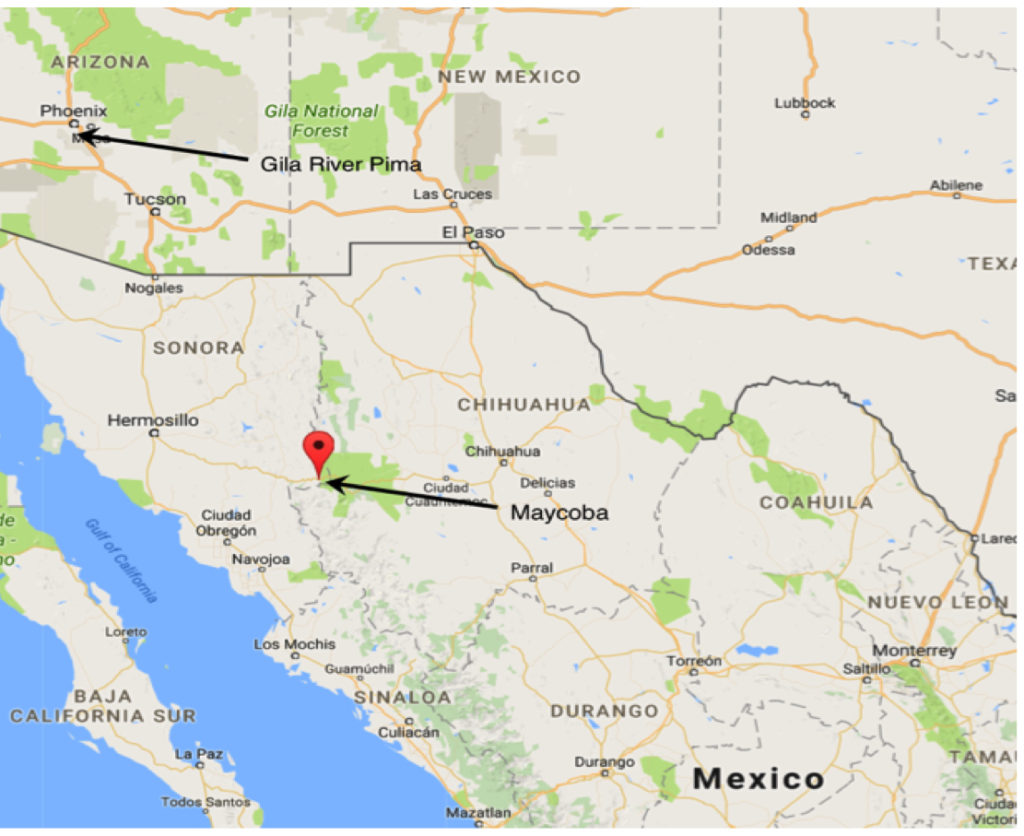
The Mexican Pima live in and near a village called Maycoba, intermingled with Mexican Indians who do not share the Pima genetic or linguistic heritage. Scientists have been studying the Arizona and Mexican Pima since the early 1990s. Although a few amenities have come into their lives, the Mexican group is still engaged in manual-labour farming, and their diet is unchanged from earlier times — high in plant material and low in fat. The interest of scientists was initially piqued by the relatively low incidence of T2DM of the Mexican group, relative to their American cousins (Figure 7). In fact, the Mexican Pimas incidence is the same as that of their non-Pima neighbours, and also the general population.
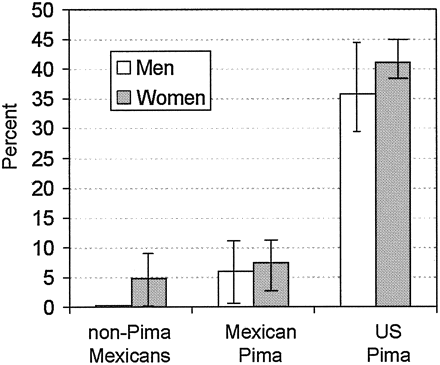
The levels of T2DM are mirrored by the levels of obesity in the three groups. The Pima and non-Pima Mexicans show only moderate levels of obesity, and are essentially identical (Figure 8).
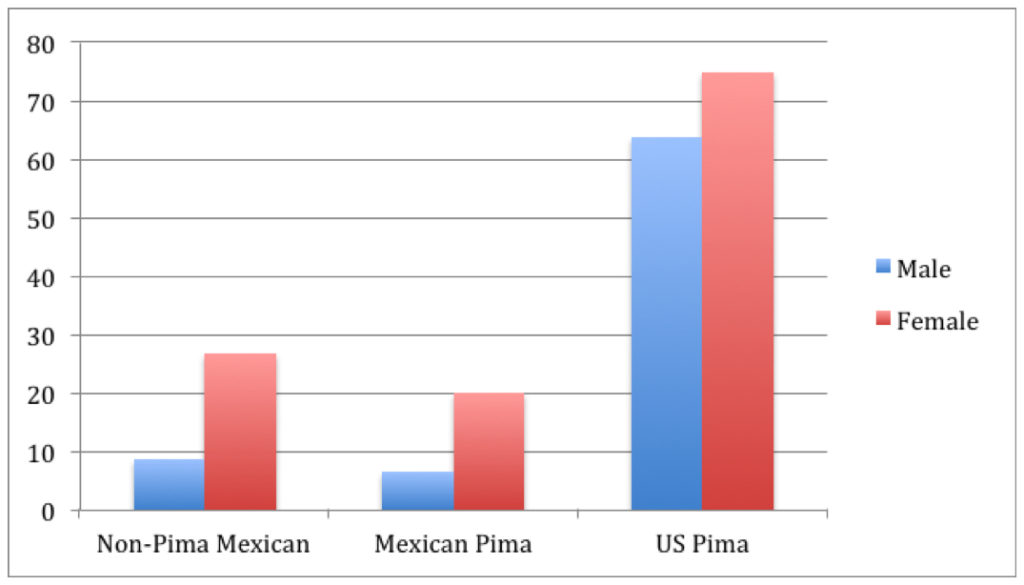
Not surprisingly, the obesity and T2DM incidence patterns are the inverse of the levels of physical activity of the groups (Figure 9). The Mexicans, Pima and non-Pima alike, are engaged in the hard work of subsistence farming, with little mechanical help. The Americans are mostly not farmers, and those that are, have mechanical devices and power. 160 years ago, the three groups were probably the same in all three categories, obesity, T2DM, and physical activity.
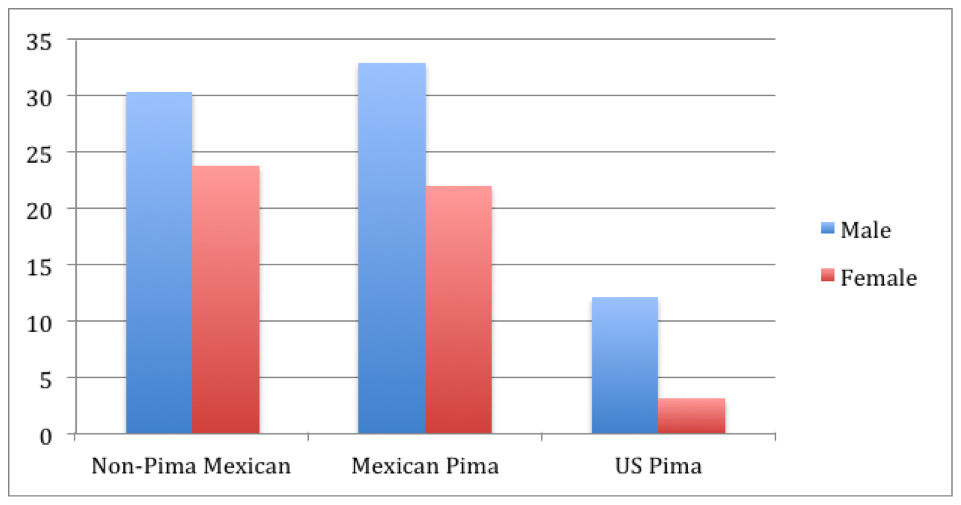
Earlier studies (6) found that the Arizona Pimas consume about the same number of calories as typical Americans. We are often told that obesity isn’t just a matter of “calories in/calories out”, and there is probably some truth to that idea for some people. But not for whole populations; calories matter, as does the amount of physical activity expended. So it is worth asking how much difference it would make to a person’s body weight to do 18 hours less of physical activity a week (roughly the difference between the Mexican and Arizona Pima’s lives). 18 hours a week of moderate work for the average person requires about the same amount of energy as contained in one pound of fat. In other words, 18 fewer hours of work a week, all else remaining the same, would add about a pound of body weight a week, 50 pounds a year. More than enough to account for the obesity epidemic of the Pimas of Arizona. Of course, things are probably more complicated than that.
The present-day Arizona Pima are trying to find their way back to economic viability and health, but it’s hard. A return to their ancient subsistence farming life is clearly neither feasible nor desirable. Today they are engaged in agriculture, off-site employment, and operating recreational activities such as casinos. But clearly (Figure 6), many are not doing much physical activity. And they hold two bad cards: they have a genetic propensity toward obesity and thus T2DM, and their former lifestyle, which kept them relatively healthy, is closed to them.
Go to Latest Posts
Work cited
- Bennett, P. H., T. A. Burch, and M. Miller. 1971. Diabetes mellitus in American (Pima) Indians. The Lancet 298:125-128.
- Russell, F. 1908. The Pima Indians. Bureau of American Ethnology, Twenty-Sixth Annual Report.
- Shaw, A. M. 1974. A Pima Past. University of Arizona Press.
- DeJong, D. H. 2016. Stealing the Gila: The Pima Agricultural Economy and Water Deprivation, 1848-1921. University of Arizona Press.
- Schulz, L. O., P. H. Bennett, E. Ravussin, J. R. Kidd, K. K. Kidd, J. Esparza, and M. E. Valencia. 2006. Effects of traditional and western environments on prevalence of type 2 diabetes in Pima Indians in Mexico and the U.S. Diabetes Care 29:1866-1871.
- Maes, H. H., M. C. Neale, and L. J. Eaves. 1997. Genetic and environmental factors in relative body weight and human adiposity. Behavior genetics 27:325-351.
- Silventoinen, K., A. Jelenkovic, R. Sund, Y. Yokoyama, Y. M. Hur, W. Cozen, A. E. Hwang, et al. 2017. Differences in genetic and environmental variation in adult BMI by sex, age, time period, and region: an individual-based pooled analysis of 40 twin cohorts. Am J Clin Nutr 106:457-466.
Back to the front page




